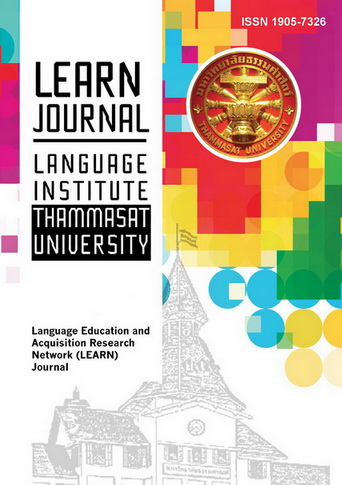Lexical Collocational Use by Thai EFL Learners in Writing
Main Article Content
Abstract
To achieve a high level of language fluency, learners need to possess sufficient collocational competence. However, collocation is considered a problematic area for many EFL learners, partly because of its arbitrariness. To gain more insight into the problems involving learners’ productive collocational skills, the current study examines lexical collocational use by Thai EFL learners in their writing. The writing of 90 university students were analyzed to show the proportion of six types of lexical collocations. Some observations regarding the differences in the use of lexical collocations by three groups of learners categorized according to language proficiency levels were made. The results suggested that verb-noun, adjective-noun, and noun-verb collocations were most frequently produced by all the three groups of learners. Interestingly, the higher level of language proficiency, the higher number of lexical collocations produced. Regarding the differences in their collocational use, the results point to the likelihood that the high-proficiency group used a wider variety of lexical collocations when compared to the other two groups, and that low-proficiency group used more generic and unclear vocabulary and produced several mistakes in terms of word choice. Based on the study results, some suggestions regarding how collocations could be taught more efficiently are presented.
Article Details
References
Benson, M., Benson, E. & Ilson, R. (1997). The BBI Dictionary of English Word Combinations. John Benjamins.
Boonyasaquan, S. (2006). An analysis of collocational violations in translation. Humanities Journal, 27(2), 79-91.
Cowie, A. (1981). The treatment of collocations and idioms in learners’ dictionaries, Applied Linguistics, 2(3), 223–235.
Detdamrongpreecha, D. (2014). The acquisition of basic collocations by Thai learners of English. SDU Res. J. 10(3), 37-53.
Erman, B., & Warren, B. (2000). The idiom principle and the open choice principle. Text, 20(1), 29-62.
Fan, M. (2009). An exploratory study of collocational use by ESL students-A task based approach. System, 37(1), 110-123.
James, C. (1998). Errors in language learning and use: Exploring error
analysis. Addison Wesley Longman Limited.
Lewis, M. (2000a). There is nothing as practical as a good theory. Teaching collocation: Further developments in the lexical approach (pp.10-27). Language Teaching Publications.
Lewis, M. (2000b). Teaching collocation: Further developments in the lexical approach. Hove: Language Teaching Publications.
Laufer, B., & Waldman, T. (2011). Verb-Noun Collocations in Second Language Writing: A Corpus Analysis of Learners’ English. Language Learning, 61(2), 647–672.
Meechai, D., & Chumworathayee, T. (2015). Verb + Noun Collocational Competence of Thai University EFL Students: A Comparative Study of a Regular Program and an English Program. Language Education and Acquisition Research Network, 8(2), 145-160.
Mongkolchai, A. (2008). A Study of University Students’ Ability in Using English Collocations. Master’s project, Srinakharinwirot University, Bangkok.
Nesselhauf, N. (2003). The Use of Collocations by Advanced Learners of English and Some Implications for Teaching. Applied Linguistics, 24(2), 223–242.
Nesselhauf, N. (2005). Collocation in a learner corpus. Benjamins.
Pawley, A. and Syder, F. (1983). Two puzzles for linguistic theory: native-like selection and native-like fluency. In Richards, J. and Schmidt, R. (eds.), Language and Communication (pp.191-227). Longman.
Phoocharoensil, S. (2011). Collocational errors in EFL learners’ interlanguage. Journal of Education and Practice, 2(3), 103-120.
Phoocharoensil, S. (2013). Cross-linguistic influence: Its impact on L2 English collocation production. English Language Teaching, 6(1), 1-10.
Renouf, A. J., & Sinclair, J. (1991). Collocational frameworks in English. In K. Ajimer and B. Altenberg (Eds.), English corpus linguistics. Studies in honour of Jan Svartvik (pp. 128-143). Longman.
Sinclair, J. (1991). Corpus, concordance, collocation. Oxford University Press.
Sridhanyarat, K. (2018). Thai learners’ acquisition of L2 collocations: An interlanguage perspective. GEMA Online Journal of Language Studies, 18(1), 1–21.
Yumanee, C. & Phoocharoensil, S. (2013). Analysis of Collocational Errors of Thai EFL Students. Language Education and Acquisition Research Network, 6(1), 88-98.


